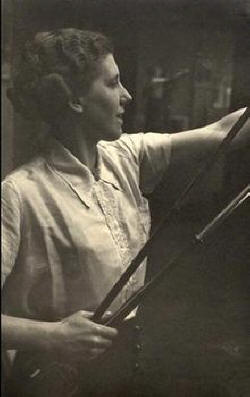

Queer Places:
Chelsea College of Arts, University of the Arts London (UAL), 16 John Islip St, Westminster, London SW1P 4JU, Regno Unito
167 New Bond St, Mayfair, London W1S 4AY, Regno Unito
 Barbara Marcia Ker-Seymer (20 January 1905 – 25 May 1993) was a British
photographer and society figure, considered one of the group designated by the
tabloid press as 'Bright Young People'. The archives of
Edward Burra
and Barbara Key-Seymer at the Tate
hold a number of beautiful photographs of black actors and performances who
worked in London during the 1920s and 1930s, including
Jimmie Daniels and
Edna Thomas.
Barbara Marcia Ker-Seymer (20 January 1905 – 25 May 1993) was a British
photographer and society figure, considered one of the group designated by the
tabloid press as 'Bright Young People'. The archives of
Edward Burra
and Barbara Key-Seymer at the Tate
hold a number of beautiful photographs of black actors and performances who
worked in London during the 1920s and 1930s, including
Jimmie Daniels and
Edna Thomas.
Born in Kensington, the daughter of Horace Vere Clay Ker-Seymer (or Clay-Ker-Seymer; his father's surname was Clay, to which for inheritance purposes his mother's- Ker-Seymer- was appended), of a landed gentry family of Dorset which had somewhat descended in wealth by this time, and Diana, the third daughter of Walter Pennington Creyke, of Seamore Place, Park Lane. Her sister, Pauline, was born in 1906.
The queer british artist Edward Burra arrived at Chelsea College of Art in 1921 at almost 16 years of age and became friends with fellow students Billy Chappell, Clover Pritchard (later de Pertinez) and Barbara Key-Seymer.
By the late 1920s Barbara Key-Seymer had become friends with the bisexual Grenadian cabaret entertainer Leslie Hutchinson. From the early 1930s Barbara became good friends with the African American gay entertainer and nightclub host Jimmie Daniels and his boyfriend Kenneth Macpherson, a Scottish modernist filmmaker and critic who earlier in 1930 had directed Borderline, a feature film starring Paul Robeson and Eslanda Robeson. Later in the 1930s Jimmie Daniels and Kenneth Macpherson moved to New York, where they socialized with individuals including Barbara's (by then) ex-girlfriend Olivia Wyndham and Olivia's girlfriend, African American Harlem Renaissance performer Edna Thomas.
During the 1930s Barbara Key-Seymer became an important and skilled modernist photographer, influenced by German expressionism. In the late 1920s she'd begun working as an assistant for the aristocratic photographer Olivia Wyndham. Soon afterwards they started seeing one another and Barbara moved into Olivia's Chelsea home at 19 King's Road. Here they socialized with upper-class lesbians such as the American heiress Ruth Baldwin and Dolly Wilde, Oscar Wilde's niecce, along with others including Edward Burra, who visited Key-Seymer and Wyndham often. The couple lived close by Ruth Baldwin and her female partner Joe Carstairs, a wealthy motorboat racer.
Ker-Seymer taught herself photography. Her work eschewed artifice, instead aiming at producing naturalistic images, with her sitters relaxed rather than posed, as though they were 'just sitting around'. These subjects included Nancy Cunard, Raymond Mortimer, Frederick Ashton, Edward Burra, Gertrude Stein and Julia Strachey.
In June 1930 author Evelyn Waugh recorded attending a Thames steam-boat party hosted by Olivia Wyndham and Ruth Baldwin, which he noted in his diary, was attended by "masses of little lesbian tarts and joyboys."
She opened her London studio- above Asprey the jewellers- in 1931, and at around the same time produced for Harper's Bazaar the photographic series 'Footprints in the Sand' about up-and-coming writers; one of her sitters was Evelyn Waugh. She was a friend of the Surrealist artist John Banting, managing to keep his suicidal moods at bay with her upbeat personality.
In Barbara Key-Seymer's personal photo album from 1936 we also see that during the 1930s she was friends with singer, actress and performer Elizabeth Welch. Born in 1904, Elizabeth Welch was an American of African, Native American, Irish and Scottish heritage. Stephen Bourne's insightful biography of Welch records her experiences in 1930s London. During this time she performed in musicals and cabaret, and starred on radio, on television and in films alongside actors including Paul Robeson. She was good friends with Leslie Hutchinson, socialising with him, as she recalled in "the marvellous late-night dives of Soho which, in those days, attracted all the stars and theatregoers."
With the onset of the Second World War and the dispersal of the avant-garde scene in which she had operated, along with changes in public attitudes and shortages of photographic supplies, Ker-Seymer abandoned her photography for work in a film studio, and spent the majority of the war living in the remote English countryside. She never returned to photography, instead opening one of London's first launderettes. She enjoyed the work, and the business became successful, which allowed her to bring up her son in security.
Ker-Seymer was married twice: first, in June 1941, to Humphrey Joseph Robinson Pease, of Yewden Manor, Henley-on-Thames,[1] a researcher for Mass-Observation;[2] second, in March 1945, to John David Rhodes (d. 2007), with whom she had one son, Max Humphrey Lionel Ewart Rhodes (later Ker-Seymer), born 1947. They divorced in 1955.[3] She died on 25 May 1993.[4]
My published books: